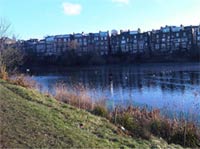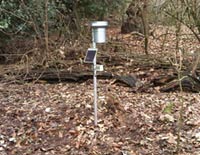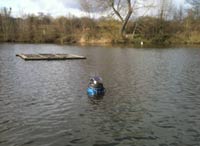The Supply and Installation of a Flood Warning System for City of London
Abstract
RS Hydro were awarded the contract to supply install and maintain a network of water level monitoring, automatic rain gauge stations and a weather station for the City of London Corporation to monitor the water levels and rainfall at Hampstead Heath. In total five ponds in the two separate chains of ponds on the heath are monitored and supported by automatic tipping bucket rain gauges and a weather station.
Equipment Used
Five Adcon GPRS A755 SDI 12 addWAVES deployed on the five selected ponds each with an Impress SDI water level and temperature sensor.
One Adcon GPRS A753 installed with a tipping bucket rain gauge, air temperature and relative humidity, wind speed and direction sensor.
2 Adcon GPRS A757 with single pulse inputs with a tipping bucket rain gauge to record rainfall and rainfall intensity. Every tip is registered with a time and date stamped to the nearest second.
2 GPRS network providers were selected and used alternatively up the chains of ponds.
Background
 Historically the local geology of the 320 Hectares that now make up Hampstead Heath have been exploited to produce two chains of ponds or reservoirs to serve London with water as the city's population rapidly expanded in the 17th and 18th Centuries. The Hampstead Water Company dug eight reservoirs on the Eastern side to catch water percolating from the ground where the permeable sands meet the London Clay. The western Hampstead chain of ponds were created by damming Hampstead Brook, which flows into the river Fleet. Over time, these manmade water bodies have become an important part to the landscape and widely used for recreation and enjoyed by the 8 million annual visitors to the Heath. This volume of visitors has caused a serious soil compaction problem causing surface water drainage rather than permeating into the soil. Water volume calculations from a rainfall event use a figure of 100% run off. At some stage all the water falling as rain will enter the pond chains as it flows towards the river Fleet. A 10 mm rainfall event across all 320ha of Heath equates to 320,000 cubic metres of water.
Historically the local geology of the 320 Hectares that now make up Hampstead Heath have been exploited to produce two chains of ponds or reservoirs to serve London with water as the city's population rapidly expanded in the 17th and 18th Centuries. The Hampstead Water Company dug eight reservoirs on the Eastern side to catch water percolating from the ground where the permeable sands meet the London Clay. The western Hampstead chain of ponds were created by damming Hampstead Brook, which flows into the river Fleet. Over time, these manmade water bodies have become an important part to the landscape and widely used for recreation and enjoyed by the 8 million annual visitors to the Heath. This volume of visitors has caused a serious soil compaction problem causing surface water drainage rather than permeating into the soil. Water volume calculations from a rainfall event use a figure of 100% run off. At some stage all the water falling as rain will enter the pond chains as it flows towards the river Fleet. A 10 mm rainfall event across all 320ha of Heath equates to 320,000 cubic metres of water.
 Changes in recent weather patterns have caused large localised flooding events across the UK. Rivers and lakes have been unable to cope with the large volumes of water discharged into them as efficient drainage systems try to cope, often a months rainfall falling in a 24 hour period. These destructive flooding events led to a review of water management which in turn led to the Flood and Water Management Act of 2010. The Environment Agency has quoted that this Act is central to reducing the flood risk associated with extreme weather. The new act is about the management of risk to people and property caused by these extreme events and as such the new regulations means the two chains of ponds now come under the act. Previously under the Reservoir act 1975 only three of the reservoirs fell into its legislation. The City of London Corporation had to rethink their risk management of the ponds on Hampstead Heath and its requirement to alter some of the dam constructions so they abide with the regulations. A thorough hydrological survey of the Heath has been carried out. Critical water levels in the ponds have been identified and banded as Amber and Red Phases. Rainfall events with duration and volumes have also been given the same bands. Before construction work begins to modify some of the dams there is a long consultation process with local residences and interested parties on how to minimise the effect of the work. In the interim, the city of London has initiated an early warning system based on rainfall radar, local rainfall monitoring and changes in water level on five of the key ponds. An emergency action plan has also been constructed based on the data from the monitoring strategy.
Changes in recent weather patterns have caused large localised flooding events across the UK. Rivers and lakes have been unable to cope with the large volumes of water discharged into them as efficient drainage systems try to cope, often a months rainfall falling in a 24 hour period. These destructive flooding events led to a review of water management which in turn led to the Flood and Water Management Act of 2010. The Environment Agency has quoted that this Act is central to reducing the flood risk associated with extreme weather. The new act is about the management of risk to people and property caused by these extreme events and as such the new regulations means the two chains of ponds now come under the act. Previously under the Reservoir act 1975 only three of the reservoirs fell into its legislation. The City of London Corporation had to rethink their risk management of the ponds on Hampstead Heath and its requirement to alter some of the dam constructions so they abide with the regulations. A thorough hydrological survey of the Heath has been carried out. Critical water levels in the ponds have been identified and banded as Amber and Red Phases. Rainfall events with duration and volumes have also been given the same bands. Before construction work begins to modify some of the dams there is a long consultation process with local residences and interested parties on how to minimise the effect of the work. In the interim, the city of London has initiated an early warning system based on rainfall radar, local rainfall monitoring and changes in water level on five of the key ponds. An emergency action plan has also been constructed based on the data from the monitoring strategy.
As with all Decision Support Systems, there are clear High risk and No risk scenarios, where these two merge is where the need for good reliable data and a good model come to the fore. Frequent and faster processing of data produces a better understanding of the situation and more time is available to manage the risk. The facts are available to allow a risk management decision to be made with confidence.
Project Monitoring Approach
 A previous installation of data buoys deployed on the ponds by another contractor and linked to a local base station via a relay proved unsatisfactory. A number of issues were identified including the topography of the site and the mature woodlands both cause problems for radio signals. The buoys radios and sensors were powered by rechargeable batteries that meant battery changes at regular intervals. A site visit quickly gave RS Hydro an understanding of the limitations of using local telemetry. The very nature of Parliament Hill and the tress meant linking the two chains of ponds into one radio network would prove hard and involve cost. The buoys however provide an ideal solution in terms of deployment, security and are the least obtrusive installation in the landscape due to their size. A key requirement was to minimise the visual impact of a monitoring system. The proposal put to The City of London involved reengineering the buoy solution to use Adcon Telemetry units that utilise low power GPRS and solar power. The advantages of using Adcon Telemetry in the buoys and installing them in the middle of the ponds are better security, higher light levels for solar power, faster deployment with minimal disturbance to the Heaths users including its wildlife. It is easier to redeploy buoys or add additional buoys to other ponds. Two small solar panels mounted in opposite directions capture light if the buoys swivel.
A previous installation of data buoys deployed on the ponds by another contractor and linked to a local base station via a relay proved unsatisfactory. A number of issues were identified including the topography of the site and the mature woodlands both cause problems for radio signals. The buoys radios and sensors were powered by rechargeable batteries that meant battery changes at regular intervals. A site visit quickly gave RS Hydro an understanding of the limitations of using local telemetry. The very nature of Parliament Hill and the tress meant linking the two chains of ponds into one radio network would prove hard and involve cost. The buoys however provide an ideal solution in terms of deployment, security and are the least obtrusive installation in the landscape due to their size. A key requirement was to minimise the visual impact of a monitoring system. The proposal put to The City of London involved reengineering the buoy solution to use Adcon Telemetry units that utilise low power GPRS and solar power. The advantages of using Adcon Telemetry in the buoys and installing them in the middle of the ponds are better security, higher light levels for solar power, faster deployment with minimal disturbance to the Heaths users including its wildlife. It is easier to redeploy buoys or add additional buoys to other ponds. Two small solar panels mounted in opposite directions capture light if the buoys swivel.
Remote Monitoring
Water level monitoring uses very low power SDI 12 pressure transducers, the sensor has a built in processor and sends the data along a signal wire as a coded sequence rather than a voltage or current output. The cable is vented to give an atmospherically compensated value. Each pressure transducer has a built in temperature sensor. The installation of the sensor ensures it is physically linked to the bottom of the pond to ensure changes in water level are accurately measured. The sensor is powered up and read very 10 mins and is then instantly transmitted to the FlowView data centre via the GPRS. The transmission only takes a few seconds so all statistical alarms and functions are performed within a few further seconds hence providing the City of London with a very responsive flood alert system.
Data Processing and Visualisation
The stations on Hampstead Heath are managed by a dedicated A850 Gateway which stores the data until it is retrieved and displayed on the web. Every minute the Adcon software scans the Gateway for new data, any new data is processed into level data represented as levels Above Ordinance Datum (AOD). These levels are compared to the previous level to see if there is any sudden change up or down. They are compared against the Amber and Red Thresholds for the relevant pond and if required email, text alarms are send to pre selected recipients and landline phones can be called with a recorded message played once the call has been answered.
